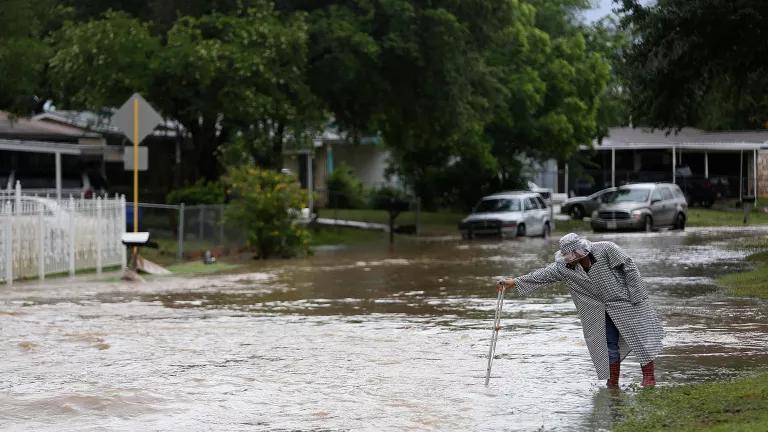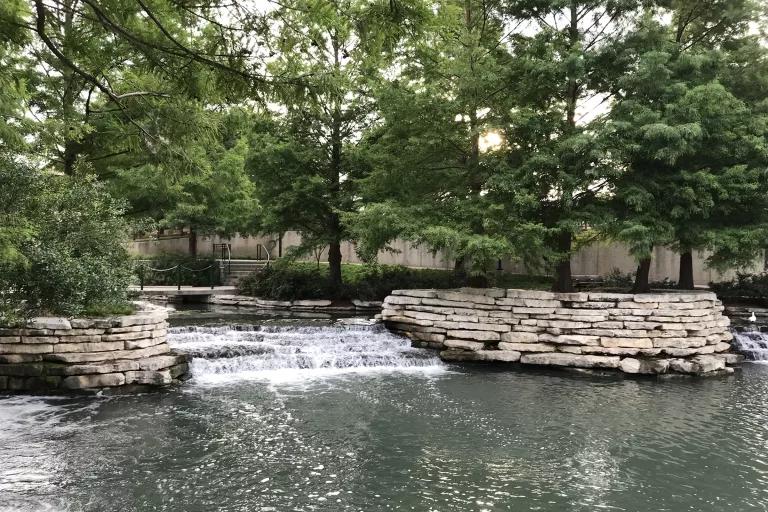San Antonio Finds the Key to Flood Control in Its Gardens
As climate change brings heavier rains, local officials and developers are managing the deluge of stormwater runoff with some low-tech—and pretty—solutions.

Flood monitoring on Castleridge Drive in the Westwood Village neighborhood of San Antonio, Texas
Rolling thunder, debris propelled by the wind, and an exploding transformer heralded the thunderstorm bearing down on downtown San Antonio, Texas, on June 24, 2019. When the storm hit in earnest, more than two inches of water pelted the streets in just a few hours. The rain spurted and whirled sideways like carwash jets. It overwhelmed the gutters, sweeping across streets and sidewalks, gathering cups, bags, animal waste, oil, antifreeze, silt, pesticides, toxic metals, and anything else loose on the ground. It plunged down storm drains and raced over embankments, directly into the San Antonio River.
The flooding was brief this time, with no loss of human life. But the city didn’t escape unscathed. When the sun rose the next day, the San Antonio River that flowed through the popular downtown Riverwalk pedestrian and cycling area was swollen and cloudy, its muddy surface festooned with foam and oil. It looked unwell, as if the river itself were sick.
“Runoff goes into the river hot, fast, and dirty,” says Karen Bishop, senior supervisor of the Stormwater Unit at the San Antonio River Authority (SARA). And as rainfall events become more extreme due to the global climate crisis, officials like Bishop in cities across the nation are increasingly tasked with dealing with stormwater runoff—plus the flooding and water pollution that result.
The traditional approach to managing stormwater is to get it out of neighborhoods as fast as possible to prevent flooding. What’s lost in that approach is any concern for water quality. The bacteria, toxic metals, and chemicals in stormwater cause mass fish kills and sicken birds, turtles, and other animals that depend on the waterways.
More recently, in recognition of the growing burden on urban waterways, some cities, including San Antonio, are turning to green infrastructure, or limited-impact development (LID). Through it, urban planners deploy healthy plant life to make riverbanks more resilient against flooding, as well as rich soil packed with high organic content to filter out pollutants before they reach waterways.

According to the Local Government Commission, a California-based nonprofit that focuses on local environmental sustainability and social equity, LID is designed to “slow . . . stormwater flows, to allow pollutants to settle out of the water; spread stormwater out over a larger area so plants and soil can filter out pollutants; [and] sink stormwater into the soil to provide water for plants and replenish groundwater.”
“Slow, spread, and sink” form an effective counterpoint to “hot, fast, and dirty.”
Visitors to San Antonio’s Museum Reach can get a firsthand glimpse of these stormwater runoff control measures in action. This linear park, a 1.3-mile northern extension of the city’s Riverwalk, connects San Antonio’s zoo, its Japanese Tea Garden, the historic Pearl District, and three museums. Its embankments are draped with protective ground cover such as Asian jasmine, and flowering shrubs like plumbago and rosemary. In addition to filtering runoff, these plants help prevent erosion.

“Biodiversity is key to preventing erosion and mitigating runoff pollution. The more kinds of plants you have, the better,” says Brent Doty, research manager at San Antonio’s Edwards Aquifer Authority, which regulates the region’s groundwater.
Near the river at Museum Reach, artificial lagoons and waterfalls form transitional zones, providing habitats for wildlife, aerating the water, and allowing aquatic plants to thrive. Signs along the river, posted by SARA, sport the hashtag #LetItSoakIn and explain to pedestrians that it’s essential to intercept runoff before it hits rivers and streams.
In addition to its environmental benefits, the city touts the project’s economic impact, considering it the spark for more than $2 billion in local development surrounding the Riverwalk extension.
The success of Museum Reach has helped inspire local landscape architects to design urban projects around stormwater management. DWG, the firm working on the renovation of the San Antonio Light and Print buildings, remnants of a defunct newspaper, received financial and technical assistance from SARA to incorporate green infrastructure in its scope of work. The project will replace paved surfaces with shade trees, a lawn, and other plantings. The grasses and shrubs in its five rain gardens will capture and filter 60 percent of the site’s runoff. Rain gardens and their larger cousins, bioswales, can eliminate an impressive 80 percent of bacteria and 60 percent of chemical pollution from stormwater.
DWG is also working on the Merchants Ice plant on San Antonio’s Houston Street, its architects adopting LID practices as they transform the building into a biotech incubator campus. The plans call for green roofs to be added, with grass, trees, and other plantings atop a moisture barrier and lightweight soil mix.
Given that roof runoff can actually be dirtier than what comes off streets, developments like these are a promising tool for urban planners looking to reduce pollution. A recent stormwater study highlighted that roof runoff includes high bacteria concentrations (think bird and squirrel poop)—and toxic metals, such as copper and zinc. A heavy rainstorm sends these metals into the San Antonio River and its tributaries at levels sufficient to kill fish, according to Bishop.
Of course, designing buildings in a tight urban space can present challenges for developers wishing to incorporate extensive green infrastructure. But even with compromises, “building up is better than building out,” Bishop says, because it reduces the nonabsorbent surface area.
Corinne Bell, an NRDC water analyst based in California, agrees about the value of avoiding sprawl. “Land use decisions like that are key to minimizing stormwater runoff,” she says. A residential tower causes less runoff than a neighborhood of houses. And, counterintuitively, “lawns can actually act like impervious surfaces,” Bell adds. “With the nonnative grasses we’re using, the roots are so dense you can get sheet runoff from lawns.” Native plants and trees are better choices; in fact, a medium-size tree can absorb more than 2,300 gallons of water a year.

Cities are only gradually discovering the economic benefits of LID—and as a result have been slow to embrace it. El Paso, Texas, learned its lesson the hard way. In 2006, the city was hit by a year’s worth of rainfall within a few days. The local infrastructure was ill equipped to handle it, and low-income neighborhoods fared the worst. Property damage exceeded $200 million. Determined not to repeat the experience, El Paso’s leaders hired resilience officers and committed to stormwater infrastructure that included the adaptation and preservation of natural arroyos to help channel and retain runoff. The city also instituted a stormwater fee in the water bill paid by businesses and homeowners and directed 10 percent of it to “the preservation of open space and greenways.”
The savings in flood damage, business closures, and operating costs have more than made up for the investment. A 2017 National League of Cities study, funded by the World Bank, examined the payoffs of these changes in El Paso and found a return on investment of more than 1,200 percent.
Doty points out that LID features like ground cover plants, green roofs, and rain gardens have a better chance of standing up to large storms than structures such as storm drains. “Even the best-engineered structures are not designed to withstand some of the storms we have here,” he says. “If you get three inches of water, like we did just the other night, I don’t care what kind of structure you have, it’s not going to stop even a fraction of the water running off.”
San Antonio homeowners would be wise to consider heeding this advice, notes Bishop, even if their properties don’t border a river. After all, she says, “If you live on a city street, you live on the river. Our roads are dry creek beds.” But when bordered by native plants, grasses, flowers, and healthy soils, they don’t have to be.
This NRDC.org story is available for online republication by news media outlets or nonprofits under these conditions: The writer(s) must be credited with a byline; you must note prominently that the story was originally published by NRDC.org and link to the original; the story cannot be edited (beyond simple things such as grammar); you can’t resell the story in any form or grant republishing rights to other outlets; you can’t republish our material wholesale or automatically—you need to select stories individually; you can’t republish the photos or graphics on our site without specific permission; you should drop us a note to let us know when you’ve used one of our stories.

Climate Change Is Worsening Houston’s Housing Crisis
6 Cities That Are Ready for Climate Change
What Is the Justice40 Initiative?